Amy Freund and Michael Yonan
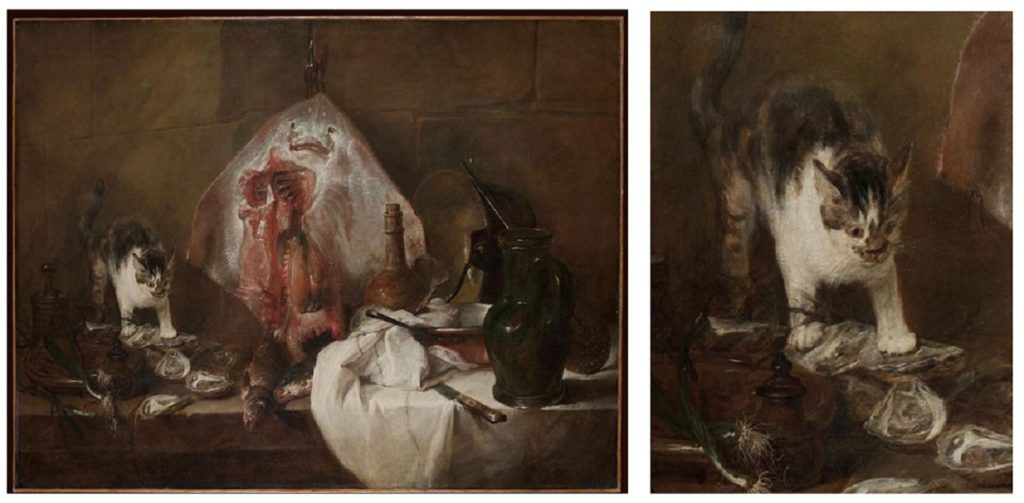
RIGHT: Fig. 1b. Detail of Fig. 1a. © RMN-Grand Palais/Art Resource, NY.
Painted cats are strange. Such a blanket statement may strike the reader as an obvious exaggeration, but a quick survey of cats in art lends conviction to the claim. Let us take a famous example, one from a canonical eighteenth-century painting, Jean Siméon Chardin’s The Ray (1725–1726) (Figs. 1a and 1b). Chardin presents us with a kitchen table covered with various raw foodstuffs and preparatory utensils. Hanging on the wall is a gutted ray, the innards of which spill out in a gory display. Viewers might recoil at such a sight, and to channel that response Chardin includes a cat, its back arched and tail flapping, which in feline bodily communication indicates fear and defensiveness. This painting’s tone contrasts with that of its companion, The Buffet, in which Chardin includes a dog, tail wagging in delight, standing before a beautifully prepared dinner table bedecked with enticing foods. The dog mirrors our pleasure at viewing such a display just as the cat mirrors our horror at gazing upon a mutilated animal.
Yet Chardin’s feline unsettles and disrupts at least as much as the carcass beside it. Seemingly weightless as it balances on an indeterminate white object (an oyster? part of a fish?), the cat’s front legs are clearly demarcated, but its hindquarters blend uncannily into the surrounding browns of the kitchen wall. Its anatomy is constructed from discrete, barely integrated parts: head, body, and hindquarters sit close together, but are disjointed and discontinuous. The cat’s face is likewise a cipher. We can make out its eyes, muzzle, and nose, but closer inspection reveals that the animal’s tabby-and-white markings obscure the details of its face. These strange painterly qualities only seem more noteworthy when we recall that the eviscerated ray conjures up the tradition of the painted anatomie, something Barbara Maria Stafford has noted in her interpretation of the picture.[1] The scientific gaze associated with that genre and evoked in the autopsied fish clashes with the vague imprecision of the cat. We might note as well that since The Ray was Chardin’s reception piece for the Royal Academy, the artist staked his professional reputation on the effect that this smudgy feline would have on its academic viewers. Since they received the painting rapturously, we must surmise that they were perfectly willing to look past its appearance.[2] It may also indicate their tacit acknowledgment that cats are hard to represent, and that Chardin, a still-life painter, could not be expected to master them.
This painting crystallizes our collected observations about eighteenth-century French representations of cats. Chardin’s frightened feline is emblematic of the century’s inability to integrate cats into the siècle des Lumières in image or in text. As we investigated this subject, it became clear that cats, and their appearance in the visual arts, provoked confusion and contradiction in their human interlocutors. Cats had long signified the irrational, the irreverent, and the demonic, reflecting a longstanding and occasionally deserved reputation as unpredictable and difficult to control. But cats, despite (or perhaps because of) this, exercised outsized power over artists, patrons, and viewers in the eighteenth century as they began to appear more frequently in domestic spaces and in works of art that recalled those spaces.
This essay investigates how cats’ tenuous domesticity and unrepentantly independent subjectivity were represented in images drawn from a key moment in feline history, namely the first half of the eighteenth century, when cats first entered elite social circles as beloved companions, and when Enlightenment ideas of human selfhood and society were spreading across the French cultural scene. Eighteenth-century artists and thinkers recognized, as had their predecessors, that cats posed a challenge to a rational and anthropocentric conception of the world. Indeed, cats embodied all that Enlightenment thinkers could not rationalize, categorize, or socialize. Not coincidentally, cats were strongly associated with female subjectivity and sexuality, forces that artists and thinkers likewise were inescapably drawn to but struggled to contain. Cats in eighteenth-century French visual culture also became an emblem of one of the Enlightenment’s most dangerous and revolutionary byproducts—personal and political liberty. Finally, and crucially for our argument, cats became a figure for the recalcitrant nature that art struggled to represent. To explore these ideas, we will focus on two paintings: Jean-Baptiste Perronneau’s Magdaleine Pinceloup de la Grange with a Cat (1747, Getty Museum, Los Angeles) and Jean-Baptiste Oudry’s Le Général (1728, private collection). As these paintings demonstrate, cats posed an irresistible challenge to eighteenth-century artists, one that emerged from their contradictory place in eighteenth-century thought. To foreground the cat is thus to foreground the problems of representation in the Enlightenment.[3] Art historians have so far sidestepped the feline Enlightenment. We will remedy that problem.
The scholarly literature on animals has grown recently by leaps and bounds, exploring animal consciousness and the human-animal relationship from varied perspectives. We follow in the footsteps of those who have identified the eighteenth and nineteenth centuries as key moments in the formation of modern conceptions of animality, even as we note that cats play a complex role in that history.[4] It was precisely in the late seventeenth and early eighteenth centuries that cats became common as beloved pets, rather than barely tolerated rodent-catchers. Here we might recall Hodge, Samuel Johnson’s beloved cat companion, and Selima, Horace Walpole’s unlucky feline whose death Thomas Gray immortalized in his famous poem.[5] However, many scholars—most famously the historian Robert Darnton—have documented a distinct ambivalence about feline nature in the Enlightenment emerging from cats’ continuing association with devilry and deviant sexuality.[6] This oscillation between love and hatred seems to echo their actual physical substance: cats are both soft and hard, gentle and vicious, friendly and aloof, dependent and independent all at once.[7]
The eighteenth-century trouble with cats is closely linked to philosophical considerations of what it is to be human and to be animal. The first great theorist of the cat, Michel de Montaigne, famously argued for the particular philosophical problem that cats posed, and for the commensurability of animal and human selves. Writing in 1580, he asked, “who knows, when I play with my cat, whether he is not enjoying himself more than I do, using me as his pastime?”[8] Montaigne’s proposal that his cat was playing with him, and was thus a thinking, acting subject, upset received human-animal hierarchies. But, as Erica Fudge has argued, Montaigne’s cat also served for the philosopher as the figure of what we do not and cannot know, and as evidence in support of his basic skepticism about the nature of things.[9] Montaigne’s ailurophilia stands almost alone in early modern thought. In Leonora Rosenfield’s classic study of philosophical conceptions of animals in the Enlightenment, dogs get several extended considerations in her text and twelve mentions in the index, whereas cats get only two.[10] When Enlightenment thinkers discussed animal reason and communication, their prime examples were almost always dogs and rarely cats.[11] The cat was a problem, and not one that most early modern philosophers and writers seemed inclined to address—falling back, like artists, on a series of ill-drawn stereotypes.
Jacques Derrida’s more recent meditation on cats offers one potential model for thinking about eighteenth-century attempts to grapple—in words and in paint—with feline nature. Derrida describes his embarrassment at being naked in front of his cat, and uses that feeling to question the primacy traditionally accorded to humans over animals.[12] Humans, Derrida argues, like to think of themselves as separate from animals, but in fact when we acknowledge the gaze of the animal, we understand the porosity of the barrier between us. Contemporary scholars of Derrida and of animals have read this text as reckoning with the limits of philosophy as well. David Brooks, for instance, interprets Derrida’s anxiety about the feline gaze as a form of castration anxiety; the cat, in this reading, is a challenge not only to philosophy but also to phallocentrism.[13] The independent, evasive cat resists easy philosophizing: it is stubbornly, frustratingly real. Fudge reads Derrida’s encounter with his cat as likewise undermining the philosopher’s arrogance. Pointing out how Derrida both emphasizes that the cat in question is his cat and reaffirms the old truism that cats never really belong to people, she argues that Derrida has difficulty abandoning his own “desire for possession and mastery.”[14] She points out that pets in general challenge the power and boundaries of the human self, our “philosophical potency.”[15] We might add that, among the animals kept as pets, cats are the greatest ontological affront to humans precisely because of their independence. It is also worth noting that Fudge, like Brooks and Derrida, uses a specifically male language of “potency,” to which the traditionally feminized cat poses special challenges.
The eighteenth-century cat likewise confronts its human interlocutors with the limits of reason, of order, of sociability, of painting—in short, with the limits of Enlightenment. No one did more to express that sense of affront, and to solidify feline–human misunderstandings, than Georges-Louis Leclerc, the Comte de Buffon, who penned an influential description of feline character in his Histoire Naturelle.[16] It was Buffon who wrote that “the cat is a faithless domestic, and only kept through necessity to oppose to another domestic which incommodes us still more, and which we cannot drive away”—namely the mouse.[17] In opposition to canine acquiescence, cats for Buffon lived a double life. He noted that even as kittens they possessed an “innate malice” (“une malice innée”), which age augmented and which contact with humans never dampened. Cats dissimulate, by which Buffon meant that they hide their true intentions. He put it thus:
Like all knaves they know how to conceal their intentions, to watch, wait, and choose opportunities for seizing their prey; to fly from punishment, and to remain away until the danger is over and they can return with safety. They readily conform to the habits of society, but never acquire its manners; they have only the appearance of attachment, as may be seen by the obliquity of their motions, and the duplicity of their looks; they never look in the face of those who treat them best and of whom they seem to be the most fond, but either through fear, or falsehood, they approach him by windings to seek for those caresses they have no pleasure in but only to flatter those from whom they receive them.[18]
Buffon’s language in this passage is unmistakably gendered; the terms he uses to describe feline demeanor overlap markedly with eighteenth-century descriptions of seductive women. Women, too, were thought in this period to hide their true desires behind an appeasing and appealing façade. Buffon further feminizes cats by describing their bodies and behaviors in terms that suggest stereotypes of dangerous femininity, regardless of whether they are female or male:
The form and temperament of the cat’s body perfectly correspond with his disposition. He is handsome, light, adroit, cleanly, and voluptuous; he loves ease, and searches out the softest places for rest and repose. The cat is very amorous, and what is uncommon among animals, the female appears more ardent than the male; she seeks for and invites him, and by her loud cries announces the fury of her desires or rather the pressure of her wants; if he flies from or disdains her, she pursues, tears, and though their approaches are always accompanied with acute pain, she forces him to comply with her desires.[19]
What troubles Buffon about this behavior is not that it is somehow different from human behavior, but rather that cats resemble human beings too closely:
Very different from that faithful animal the dog, whose sentiments are all directed to the person of his master, the cat appears only to feel for himself, only to love conditionally, only to partake of society that he may abuse it; and by this disposition he has more affinity to man than the dog, who is all sincerity.[20]
Here Buffon puts into play an idea that turns out to be important for eighteenth-century thinking about cats: that their independence is something that human beings likewise possess, and that they are, in essence, creatures of liberty and libertinage. If dogs present human beings with an ideal paradigm of nature, acknowledging the human race’s superiority and acquiescing to it, cats are more evenly matched to us in their mental powers. They are also in it for the benefits, associating with humans only to get what they want, and, in so doing, reflecting our selfishness back to us. This realization that cats treat us the way we treat them—and, by extension, the way we treat all animals—implies that human beings are simply another species in the animal world, and this denigration of human status in nature troubles Buffon terribly. It is an idea that does not fit into his Enlightenment view of a rational nature that human can harness for better ends.
Buffon explores this issue when he addresses the question of cats’ domesticity. He notes that, although they live in our houses, cats are not domesticated. “It cannot be said that cats, though living in our houses, are entirely domestic. The most familiar are not under any subjection, but rather enjoy perfect freedom, as they only do just what they please…”[21] Buffon traces this semi-wildness to the idea that pet cats and wild cats interbreed, which is why some house cats resemble their wild brethren so closely. The question of domesticity required extra explanation at this historical moment, when cats became widely recognized as potential companionate animals.[22] Buffon’s explanation was necessary at a time when so many cats began to appear in French households in this new role.
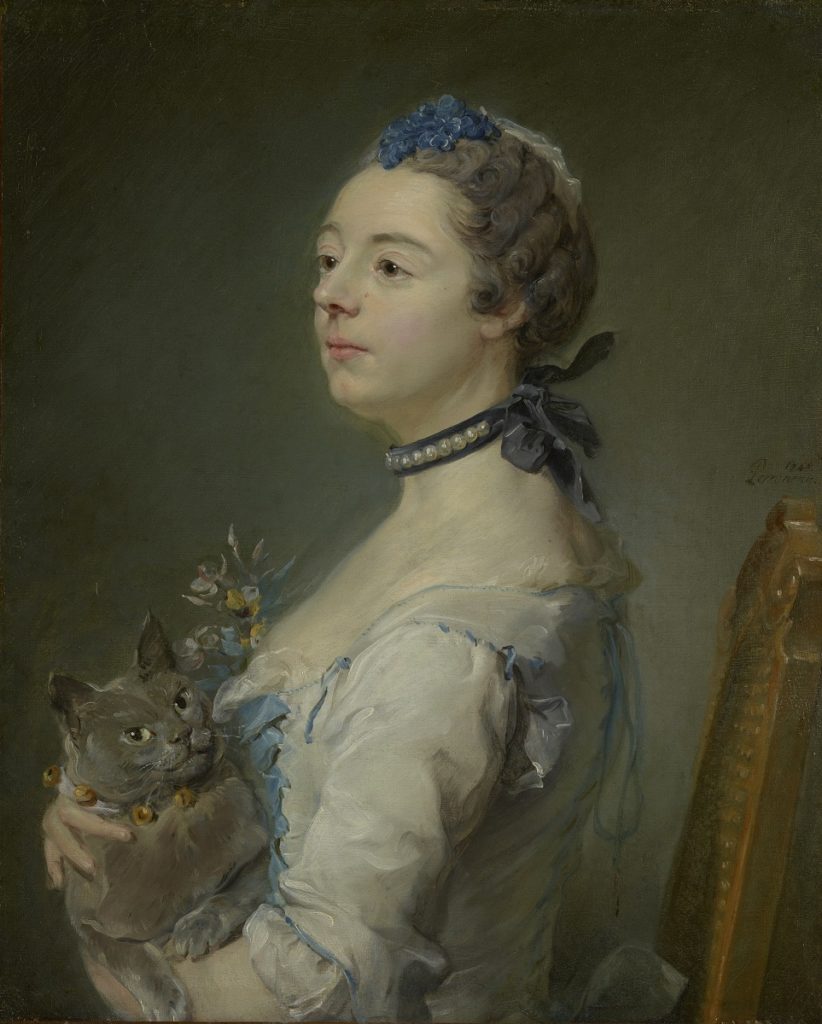
This tension between the cat’s new role as pet and its apparent resistance to domesticity inflects one of the most striking images of a cat in eighteenth-century French painting: Perronneau’s portrait of Magdaleine Pinceloup de la Grange (Fig. 2). Pinceloup’s husband Charles-François (whom Perronneau also painted) was from a family in the weaving business that specialized in producing muslins for cheese production. That is a telling fact, as muslin was a common, humble cloth, yet a necessary one for French commerce. Working in that business probably put the family into contact with textile importers and possibly animal traders as well. Pinceloup appreciated her pet cat so much that she sat for her portrait with it.[23] One reading of the painting would claim that the female sitter and cat parallel each other, that the cat is the animal equivalent of the human being beside it. A closer look complicates an easy equation of human and feline.[24]
We see that first in the cat’s pose. As ailurophiles well know, some cats do not like to be held. In what is a virtuoso manipulation of the painted surface, Perronneau conveys tension in the animal’s limbs, neck, and head, and this combines with its somewhat nervous, distant gaze to suggest that the cat is begrudgingly letting itself be handled, but is not enjoying it. Pinceloup’s cat, in other words, does exactly what Buffon said cats do: it has infiltrated human society but retains an independence that makes it only partially subordinate to its mistress. Perronneau’s painting also suggests that this particular animal’s instincts have caused trouble in the past. The cat wears a collar with bells on it. Such collars were used to identify individual animals and decorate their bodies, but the bells also functioned to give birds and other small animals warning of an imminent strike. The bell-laden collar is therefore a concession to domestication that this cat accepts because it must. Raw instinct is conveyed in the cat’s tense pose, which hints at the imperfect domestication implied through the collar.
One could pursue this interpretation further and, following Buffon again, understand Perronneau’s hinting at the cat’s baser urges as a commentary on the errant desire of women. But Pinceloup is calm, assured, and confident in a way that her cat is not. A better approach for linking feline and human would be to think of them both as decorative. Perroneau used an ashen blue paint to convey highlights on the cat’s fur; one sees it in the area below its eyes, around the mouth, and on its paws. This precise color is picked up in the blue ribbon trim of Pinceloup’s dress, and it appears again in the shadows of her gown and curls of her hair, which mimic exactly the tonalities of the cat’s fur. If there is a connection to be made between woman and feline, it is not in their personalities or demeanors, but rather in the beauty and luxury of their external surfaces and the ways in which fur, hair, ribbon, and silk can be conveyed in like manner through paint. This similarity in paint draws attention to the analogies between human and feline nature, particularly in each being’s desire to assert its independent existence in the world, which is in essence what portraits achieve. Perronneau’s sensitivity to this animal as a parallel in beauty to Pinceloup makes it one of the finest cat representations in eighteenth-century French art. The artist’s attention to the feline indicates that the picture is a double portrait, very much unlike most eighteenth-century representations of humans and animals together. Pinceloup’s cat is clearly an independent self.
It is important for our understanding of this picture to note that this is no ordinary cat, but rather a specific breed of stocky cats with blue-gray coats popular in France. Such animals were first documented in the sixteenth century. The poet Joachim du Bellay, in the first literary work in France to describe a cat as a companion animal, penned an Epitaphe d’un chat (1558) in memory of his cat Belaud, and in it he implies that such cats were native to France.[25] In the eighteenth century they were given the name they now bear: Chartreux. The term was first used by Jacques Savart in his Dictionnaire universel de commerce, d’histoire naturelle, et des arts et métiers of 1723, where he noted that the Chartreux’s gray-blue coat made them highly prized in the fur trade—a remark that throws into relief the ambivalent status of the cat as both prized pet and livestock.[26] Brûlons’s description was the basis for the Chevalier de Jaucourt’s later entry on cats in the Encyclopédie and for Buffon’s text.[27] There was debate, however, about exactly where the Chartreux originated. The traditional story is that they were bred by the monks of the Grand Chartreuse, which gave the breed its name. This was a widely accepted narrative in the eighteenth century that has survived intact to this day, but modern genetic studies have confirmed that the breed likely originated in the mountainous areas of Lebanon, Turkey, Iraq, and Iran, and was bred by Middle Eastern traders specifically to sell to the West. Gray cats entered the European marketplace alongside breeds that bore more obviously the mark of the exotic, namely Angoras and Persians.[28]
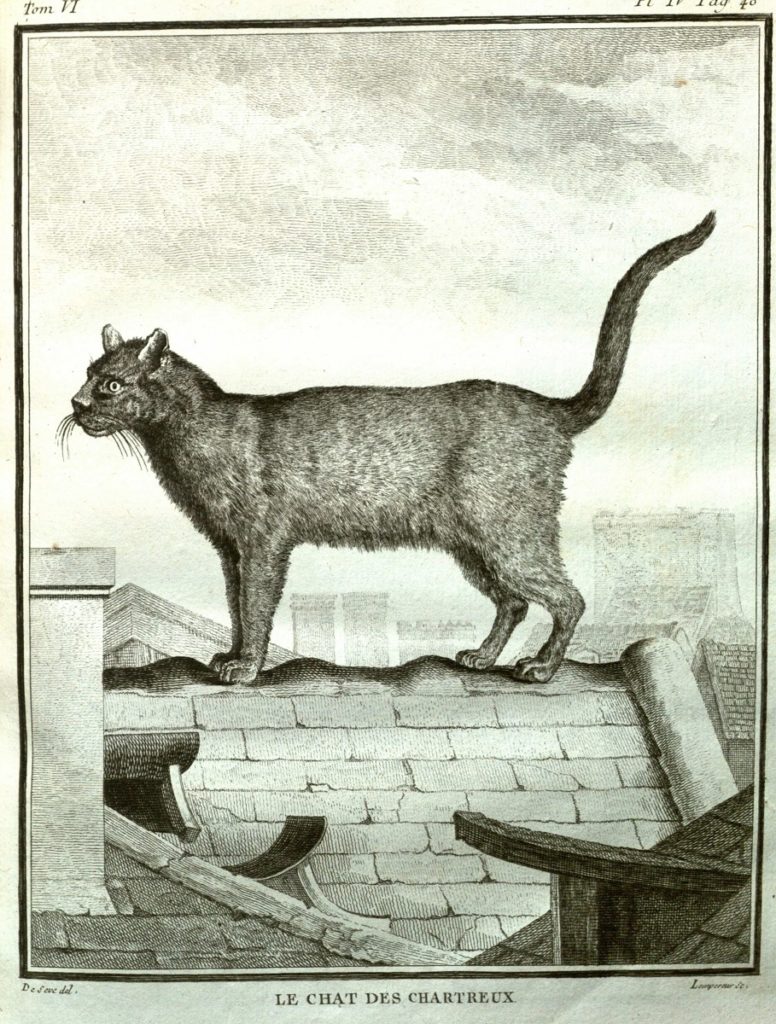
Longhaired cats like these were highly prized animals and relatively new to the French animal marketplace in the eighteenth century. So was the Chartreux, but that breed, due to the similarity of its coat color to the cloaks of Chartreuse monks, was quietly recategorized as French. The Chartreux began to be described (falsely) as a “common” or “local” breed, one native to France, and therefore as evidence that France produced beautiful cats on par with imported specimens.[29] Buffon referenced this false genealogy for the Chartreux when he included an image of one in his Histoire naturelle (Fig. 3). The feline is represented strolling the rooftops of Paris as a common street animal, in contrast to the Turkish Angora, who poses on a luxurious writing desk in a beautifully decorated interior, a printed receuil of flute music immediately beside him (Fig. 4).[30] Owning a Chartreux in the 1740s would have identified Pinceloup’s devotion to French excellence and domestic luxury. When observed alongside Buffon’s plates, Perronneau’s painting highlights the ways in which Pinceloup’s cat is simultaneously French and luxurious, but is also an uncontrollable guttersnipe.
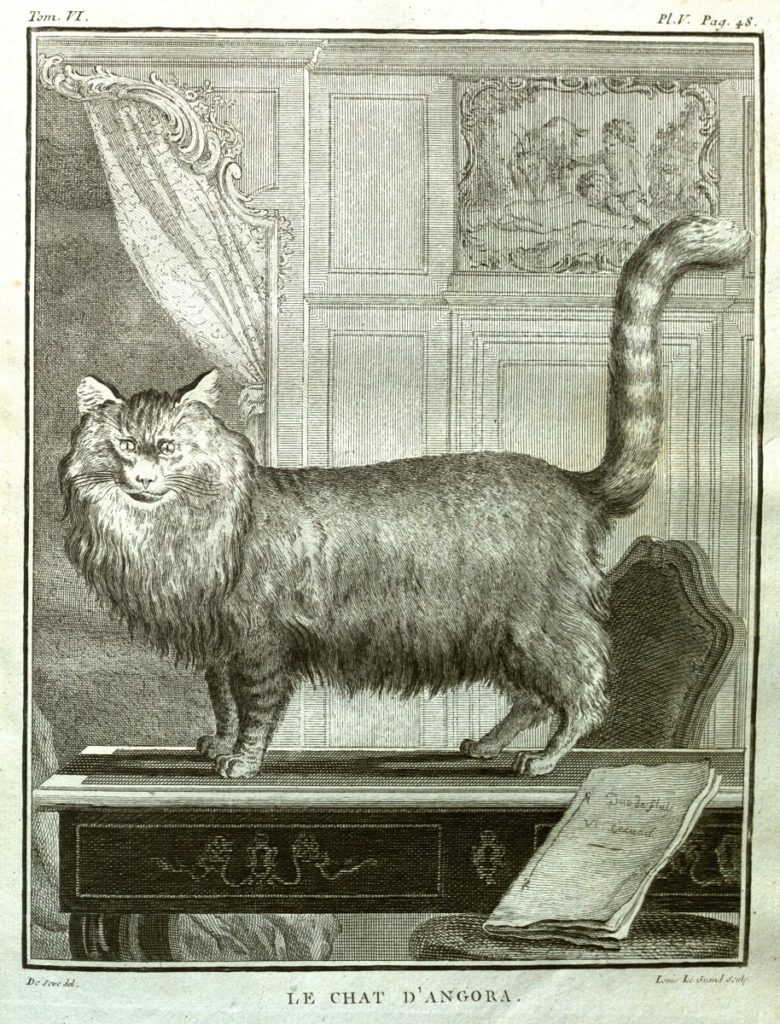
Even more meaningfully than that, the Chartreux’s fur was linked explicitly to the effects of paint on a canvas, which suggested that this breed of cat was itself like a work of art. The idea is traceable to the Italian composer Pietro della Valle, whom Buffon quoted as an authority on the breed. Della Valle’s reference to the Chartreux occurs in his diary for 20 June 1620, written when he was traveling in eastern Iran:
At this point I have found in this country a very beautiful species of cats which are native to the province of Khorasan, but of another appearance and quality than those of Tyre [Lebanon]. We estimate them to be of high value; however, they mean nothing to the people of Khorasan. I am inclined to bring them to Rome and to populate Italy with this breed. Their size and their form are like those of ordinary cats. All their beauty is in their coat which is gray without any speckles and without any spots, of one color throughout all the body, being a little lighter on the chest and the stomach which goes somewhat whitish, with an agreeable shade of light brown, as in paintings when one color is mixed with the other to give a marvelous effect.[31]
Cat fur is associated here specifically with paint; the complexities of coat shading are like the gradations of hue, of chiaroscuro, that give liveliness to a painted surface. Following Della Valle’s image, one can imagine Baroque Rome overrun by gray cats who become yet another component of that city’s artistic riches. By employing these terms, Della Valle and later Buffon use the mysteries of the artistic process to evoke the complexities of cats, and in so doing position feline beauty somewhere in the space of the imaginary, the illusionary, and the deceptive. This is possible because a cat’s fur specifically evokes couleur, the dimension of paint long associated with femininity and seductive illusion. One possible inflection of this idea onto Perronneau’s image would be to imagine that the connection among paint, fur, and noncompliance is visible in the brushstrokes used to convey Pinceloup’s Chartreux. We shall soon see that couleur, or the lack of it, likewise plays a role in Oudry’s painting.
Perronneau’s double portrait prefigures the objections to cats raised in Buffon’s 1756 text. But it also makes a case for the value and interest of the feline self, both in its relationship to the human and as an autonomous entity with the potential to escape both the artist’s and the sitter’s control. From the Perronneau portrait, which pictures human and animal together, and Buffon, who has a considerably less sanguine view of the similarities between cats and humans, we now turn to a text that celebrates the cat as a subject worthy of regard in its own right. We shall go backwards in time two decades to François-Augustin de Paradis de Moncrif’s 1727 book Les Chats, the most famous eighteenth-century assessment of the history and nature of the human-cat relationship prior to Buffon. Moncrif was a prototypical Enlightenment man of letters. A writer of prose and poetry, he served as a secretary to several important figures at court, was admitted to the Académie Française in 1733, and was appointed to the position of reader to Marie Leszczyńska, Queen of France, in 1734.
Although he would live to be ashamed of it, Les Chats was and remains his most famous work.[32] It is both a defense of cats and a parody of erudite writing, bulging with references to antiquity, citations of Locke, and reprintings of pro-cat poems and dialogues, all documented with lengthy footnotes. Its satirical tone, however, masks a wealth of information about the love for cats in eighteenth-century France, as well as the prejudices against them. Although it has generally been regarded as a philosophical trifle, this view underestimates its importance. Moncrif’s book is in fact a serious consideration of the relationship between animals and humans in the early eighteenth century, more nuanced than Buffon and far more interested in the ways in which cats were embedded in eighteenth-century social structures and artistic representation.
Moncrif confirmed that cats were associated—unfairly, in his eyes—with unbridled sexuality, unpleasant vocalizations, and foreignness. They were victims of ignorance and prejudice, ridiculed in fables and tortured in folkloric rituals. Humans would benefit, he argued, from defeating their anti-cat prejudices, which proceeded only from ignorance. For instance, he pointed out that the cries of the cat were reputed to be unpleasant, but so was the music of Asia. The problem was mutual misunderstanding between cats and humans as well as between France and non-European nations: “each Nation, in this regard, is, so to speak, the Cat of the other.” [33] In other words, the cat was a figure for strangeness, but that strangeness was really an illusion; humans and cats had much in common and were in fact interchangeable, as Buffon later would claim. Moncrif cited many examples of his contemporaries’ attachment to cats, praising their superiority as beings and as companions. He was particularly eloquent on the subject of cats’ independence and also stressed the value they placed on liberty, citing the example of ancient Gaulish tribes, “amateurs of liberty who knew no symbol more suited to represent it than the Cat.”[34] Moncrif compared cats, with their love of independence and their self-regard, favorably to dogs: “In the most perfect Dog we find only a faithful slave; in our Cat we possess an amusing friend.”[35] Their self-regard, moreover, was entirely justifiable, because cats possessed a “physiognomy,” brilliant eyes and notable mustaches that gave them attractive faces full of character.
To possess physiognomy was not only to be a person, but to be a valuable person, and indeed a common insult lobbed at dull people in the eighteenth century was to say that they had no physiognomy.[36] Étienne La Font de Saint-Yenne, in his 1747 essay Réflexions sur quelques causes de l’état présent de la peinture en France (written the same year that Perronneau produced his portrait of Magdaleine Pinceloup and her cat) famously inveighed against the proliferation at the Salon of portraits of obscure private citizens, arguing that portrait painters were “forced to flatter a simpering face, often misshapen or decrepit, almost always without physiognomy, multiplying obscure beings, without character, without name, without place and without merit.”[37] It is fair to say that La Font would have included both Pinceloup and her cat in the category of “obscure beings,” a term that denied humans without physiognomy the status of personhood. Moncrif took a more optimistic view, crediting cats with physiognomy and personhood, and thus elevating them, and their portraits, into a higher realm than many of the portraits and people upon which La Font heaped his scorn.[38]
Moncrif’s text confirms both that cats enjoyed an equivocal reputation in the eighteenth century and that their partisans were ferocious in their defense. Indeed, the elevation of the cat to the dignity of portraiture by Perronneau and his patron indicates the degree of regard that humans had for cats. Moncrif himself anticipated both the desire for, and the difficulties of, cat portraiture. His text bore witness to the human impulse to portray and immortalize cats, citing among other sources a poem attributed to the duchesse du Maine, princess of the blood and famous salonnière and political agitator, who wrote that someone who “wanted to make a picture of my Minon would need an excellent brush to sketch such great kindness, such fine qualities, such adorable suppleness.”[39] But cats, Moncrif argued, resist representation. As proof, he recounted the story of a woman who, enamored of her cat, dressed him in fine clothes and jewels (including a string of pearls around his neck) and held him up before a mirror – only to have him flee her arms and her home. “It appears from this adventure,” Moncrif noted, “that cats do not like to represent; all that has an air of subjection is repugnant to that independence to which they are born.”[40] Moncrif uses “to represent” here in the eighteenth-century sense of putting on a public face for others, but the anecdote of the cat fleeing the mirror, the surface that reproduces its face and body, suggests that cats also resisted the representation of the self inherent to the act of portraiture.
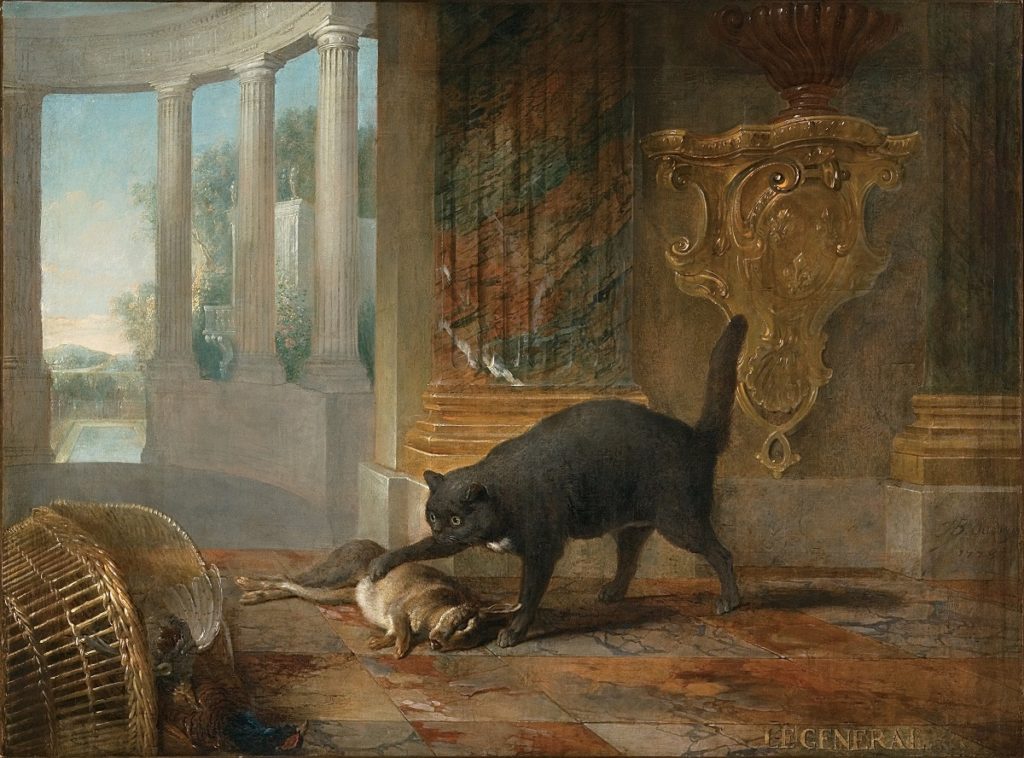
Is Perronneau’s cat a résumé of the challenges cats (and even nature more broadly considered) posed to representation? Is it perhaps even an internal critique of portraiture itself, materialized in the body of the cat squirming to get away from its human companion, from the painter, and from us, the viewers? If so, the cat’s resistance to representation has to be balanced against the artist’s and viewer’s evident delight in the attempt to represent it. The cat itself, we might argue, figures the problems inherent in capturing the self in paint, whether that self is feline or human. That tension between delight in and critique of portraiture, and of self-regard, is intensified when the cat becomes the sole focus of the painting. Such is the case in a painting by Jean-Baptiste Oudry, Le Chat Général (Fig. 5), commissioned by Louis XV and signed and dated 1728.
In Oudry’s image, the body of the cat takes up a small proportion of the canvas, which is typical of other animal portraits executed for the French king, but different from human portraits or from animals included in human portraits like Perronneau’s. Collarless and uninterested in any potential human viewer, Le Général paws the corpse of a hare with a proprietary gesture. The overturned basket of game at far left and the traction implied by the curled paw points to theft rather than lawful pursuit or obedient vigilance. This would certainly be consonant with the tradition of the cat as criminal, disrupting still lifes and stealing provisions intended for the human viewer, a visual convention grounded in Flemish animal painting and followed by French artists like Chardin.
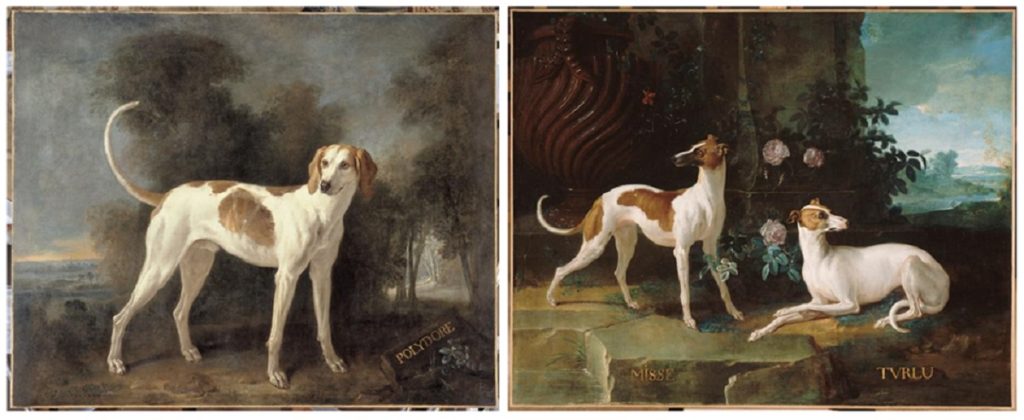
RIGHT: Fig. 7. Jean-Baptiste Oudry, Misse and Turlu, 1725. Oil on canvas 127 x 160 cm. Château de Fontainebleau. © RMN-Grand Palais/Art Resource, NY.
Le Général was conceived as part of a series of eleven overdoors painted between 1725 and 1732 that were hung in the king’s private apartments and council room at Compiègne, a royal hunting château outside of Paris. Of the ten other paintings, nine portrayed dogs (of which one included a human forest guard) and one pictured the king’s ducks. The duck portrait, alas, is unlocated, as is one of the dog portraits, but the remaining dog paintings in the series all situate their subjects outdoors. Some are members of the king’s hunting packs (Fig. 6); others are lapdogs posing like hunting dogs to somewhat comic effect. All are engaged in demonstrating their superior hunting skills, obedience, or conformation; some are in pursuit of birds, and one retrieves a dead bird for the benefit of the human hunt staff member. All, like Le Général, are named in gold letters on the canvas’s surface. One other painting in the series hints at the kind of palatial setting the king’s cat enjoyed: Misse and Turlu, two miniature greyhounds, pose elegantly in front of a rose bush and a porphyry vase (Fig. 7).
Only one of the animals portrayed in the series occupies an entirely domestic setting, and seems bent on upsetting or stealing the game procured by others. That would be the cat. Oudry places Le Général in an environment far more grandiose than his canine portrait subjects: a palace with polychrome marble floors and pilasters, decorated with a porphyry vase—the same porphyry vase, in fact, as in Misse and Turlu’s portrait, creating a circuit of luxury goods between the overdoor paintings.[41] The vase is displayed on a gilded corbel that is a textbook example of high rococo design. The palatial interior, all multicolored matter, gives way to a view onto a terrace and landscape ornamented with classical columns and urns—nature manipulated and ornamented right down to the rectangular pool we glimpse through the colonnade. As in Perronneau’s portrait twenty years later, Oudry’s painting juxtaposes animal and decorative objects, and we might be tempted to consider the cat as equivalent to the markers of luxury consumption that loom behind him. But Oudry’s cat refuses to be subsumed into the world of material goods. Le Général is at once the self-assured occupant of this manmade realm and the uncontrolled animal who overturns it. His erect tail, overlapping and disrupting the rococo corbel, is a rebuke to the artisan’s attempt to give inert material the vitality of nature. The body of the (semi-)domesticated cat, Oudry implies, is the more compelling embodiment of the combination of nature and artifice.
Oudry’s black cat, like Perronneau’s grey one, prompts us to return to the problem posed by color, and by extension color’s role in painting. But Le Général is in many ways the opposite of the Chartreux—scruffy, short-haired, collarless, and colorless. Eighteenth-century scientists and artists alike, building on the discoveries of Isaac Newton, considered black to be the absence of color, although the relationship between optical theory and actual artists’ pigments engendered considerable confusion.[42] Oudry himself, in a discourse on color that constitutes one of the rare records of his practice, wrote that in nature nothing is really black: “Never does she [nature] offer us anything black except that which is not only deprived of light in general but also set back deep enough so as to be absolutely deprived of reflections.”[43] That said, Oudry’s cat appears to contradict his own words; it is indeed black. Either the cat is an unnatural being (a proposition eighteenth-century cat-haters would have supported), or it represents the triumph of color’s absence, a contradiction of the artist’s own attempts to codify the rules of representation. Le Général’s small white bib heightens our attention to the blackness of his coat and connects his body even more closely to eighteenth-century debates about the nature of black and white, darkness and light. Those debates often moved from questions of optics and artists’ pigments to moral judgements about Enlightenment and the lack thereof. Le Général, already depicted as semi-domesticated and a morally ambiguous actor, is also a figure for the tenuousness of light, and by association of Enlightenment.[44] The black cat is that which cannot be painted and which escapes control. This prefigures the situation in Perronneau’s portrait, in which the belled cat likewise just coheres into a representational form that echoes through color the identity of his mistress. Perronneau’s cat, however, is a celebration of the mastery of the painter at the expense of the female sitter who ultimately fails to dominate her beast. In the case of Oudry, the artist’s mastery seems less certain, and by association so does the viewer’s.
The hard-to-master multi-colored or no-color cat, from Chardin’s calico kitten to Oudry’s black cat to Perronneau’s Chartreux, is twinned in eighteenth-century representation with the hard-to-define qualities of color in Enlightenment optical and color theory. Both cats and color were the subject of intense debate, and artists seem to have seized upon cats as a figure for the challenges of color in painting itself. The question of color’s place in painting, and its status relative to line, dominated aesthetic polemics in late seventeenth-century France; by the early eighteenth century, the advocates of color (Oudry among them) were firmly in control of the discourse. The writings of theorist and amateur Roger de Piles, especially his oft-reprinted Dialogue sur le coloris (1673), were critical to the triumph of color. Artists’ fascination, and trouble, with cats should be read against this larger aesthetic concern with the seductions of color, but cat painting also engages with De Piles’s ideas about mimesis and deception. As Jacqueline Lichtenstein has argued, De Piles links color to what he regards as painting’s goal: the imitation of life rather than of an ideal, and the deception of the viewer, a deception that verges on the magical.[45] The eighteenth-century cat is, in light of this argument, the perfect avatar of painting’s deceitful, even magical, qualities—and of the difficulties faced by painters hoping to replicate, and master, the real. De Piles made the recalcitrant sensuality and inherent trickery of painting into a virtue, just as eighteenth-century elites embraced the cat despite its longstanding association with the demonic and its reputation as untrustworthy and essentially undomesticated. Oudry’s Le Général is an early attempt to represent a cat as both domestic and wild at the same time; Perronneau’s Chartreux painting is a subtler and even more potent exploration of the same contradictions.
It is no surprise, then, that Le Général is clearly the mauvais sujet among all the king’s dogs (and ducks): thieving rather than hunting; black rather than white (which was the most cherished color for hunting dogs); and, according to early inventories, hung in the passageway along the terrace, rather than in the Council Room or the king’s chamber.[46] The cat’s confident occupation of his sumptuous setting, and even the memorialization of his bad behavior, nonetheless reflects the value that the king and queen placed on their feline friends. To our knowledge, there is no written record of a royal cat named Le Général, but the royal couple clearly shared their space with several felines. Louis XV was famously fond of his white angora cat, who slept in the royal Council Chamber on a scarlet pillow. One evening his courtiers took it into their heads to pour eau de toilette on the cat’s paws, which made it leap around as the alcohol burned it. The king walked in on the scene and silenced the courtiers’ hilarity with a stern rebuke: “If you want to amuse yourselves, I expect that it will not be at the expense of my cat.”[47] This strong sense of the dignity of the royal cat, and its alliance with the king’s own authority, is echoed in Marie Leszczyńska’s equally frosty chastisement of a court lady who dared to complain that the queen’s cat had ruined her fur-lined satin pelisse—an item, one can imagine, with enormous appeal to a cat looking for a soft place to sleep. The queen received these complaints as a flagrant breach of court etiquette; the queen’s cat far outranked the lady, and to insult the cat was to insult the crown.[48]
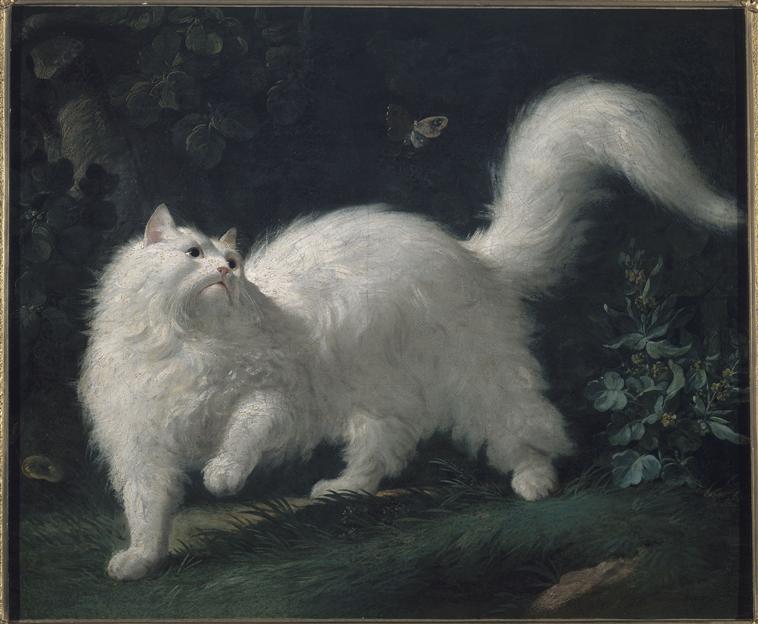
While the eighteenth-century love of cats is well-documented, portraits of cats are rarer than portraits of dogs—which, given the equivocal reputation of cats and the challenges of painting them, is understandable. Oudry is only known to have executed two other cat portraits, both in the 1720s and 1730s.[49] Later in the eighteenth century, Jean-Jacques Bachelier would take up the mantle of cat painting; his portrait of a white angora cat chasing a canary, shown at the Salon of 1761, attracted praise from Denis Diderot himself, who remarked approvingly on the cat’s “treacherous physiognomy” and declared “one could not do better.”[50] Diderot may have found the cat’s physiognomy treacherous, but he acknowledged the cat as a worthy subject for portraiture. The fact that Bachelier painted a replica of the canvas, with a butterfly substituting for the canary (Fig. 8), raises the problem of generic representation versus individualized likeness that bedevils all animal likenesses, but we should not forget that portraits of humans, especially famous ones, were also copied and collected by patrons outside the sitter’s immediate circle. Bachelier’s painting recapitulates Oudry’s royal cat portrait insofar as the white cat is also portrayed as a predator. And, like Oudry’s and Perronneau’s cats, Bachelier’s sitter invites the viewer’s caress even as it asserts a self-sufficiency tinged with menace.
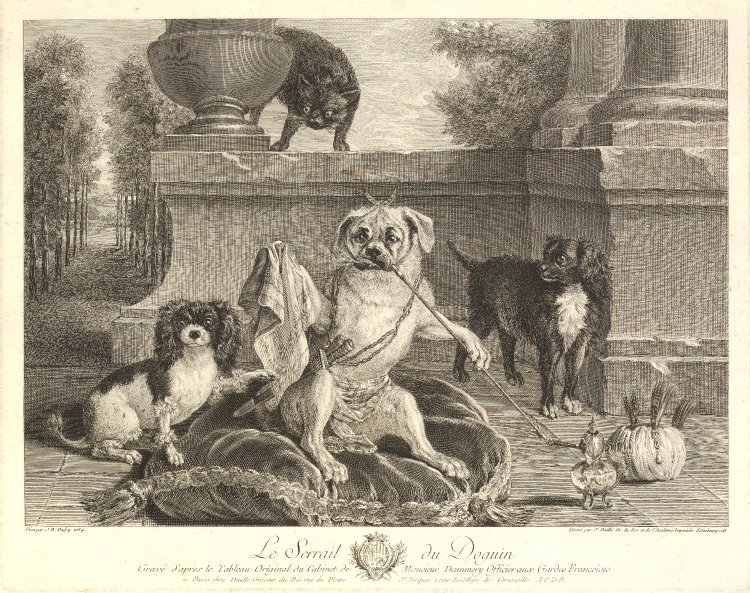
Le Général, in his coloring and gesture, also resembles cats in Oudry paintings that trade in stereotypes rather than individualization. These paintings—The Pug’s Harem (1734) and The Cat and the Monkey (1738)—feature cats fulfilling the Enlightenment’s worst stereotypes. In The Pug’s Harem, a black cat lurks behind another porphyry vase, spying on (or plotting to attack) a canine sultan smoking a hookah and offering the handkerchief of royal favor to a coquettishly trimmed miniature spaniel. The image was widely disseminated in a 1758 print (Fig. 9). Elisabeth Hardouin-Fugier has suggested that the black cat represents Persia in an elaborate political allegory of Franco-Turkish relations.[51] Even if we set aside an allegorical reading and the association of the cat with a possibly threatening foreign power, the black cat reads as a powerful, menacing figure monitoring the scene from the background. The Cat and the Monkey, on the other hand, makes the greedy black cat into the monkey’s patsy, tricked into burning its paws as it retrieves chestnuts from the fire for the monkey’s delectation (Fig. 10). Menacing, licentious, greedy, duplicitous, and the victim of duplicity itself—this is the other side of the Enlightenment cat, one that would be present in the minds of Le Général’s viewers, and articulated by Buffon a few decades later.
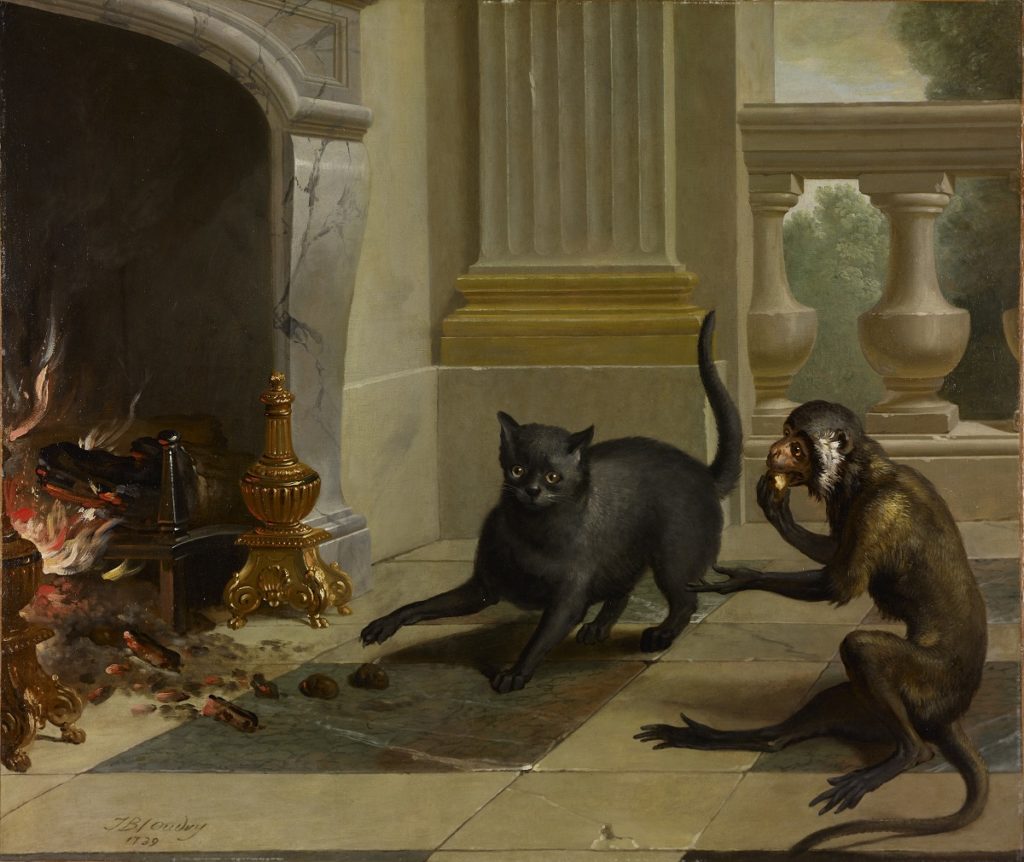
Le Général belongs to this universe of Oudry cats, and the fables and exoticism that underlay that universe would surely have resonated with its courtly viewers.[52] But Le Général is very clearly the portrait of a named individual, a portrait that, like many other likenesses of sitters notable for their beauty, bloodlines, or achievement, was displayed as part of a gallery of other portraits. The cat’s name, moreover, is not (like those of the king’s dogs) diminutive or feminine: it is martial and masculine, implying both violent action and the command of others. This could very well be a joke, since cats were traditionally associated with women, but it is nonetheless a joke that cost the king a lot of money and that remained before his eyes in a place of honor in his hunting château. Louis XV, like Madame de Pinceloup, viewed his cat as an individual, with a physiognomy and a character that deserved memorialization.
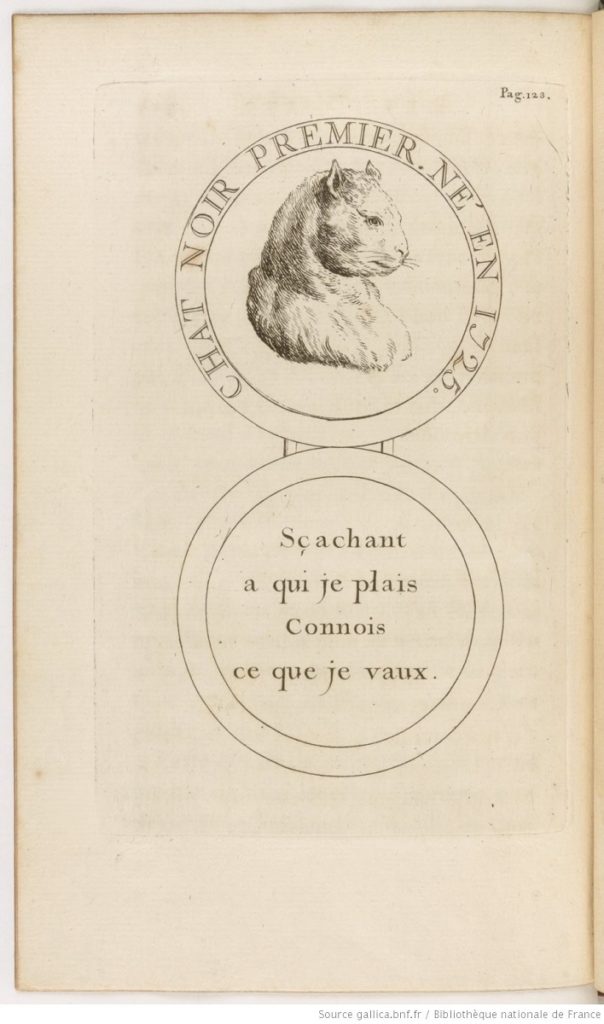
Moncrif’s treatise, published the same year that Oudry began producing the animal portraits for Compiègne and clearly well-known in elite circles, offers not only a general context for Oudry’s cat pictures but also specific resonances with the portrait of Le Général. For instance, Moncrif singled out black cats, acknowledging the special prejudices from which they suffered but also providing a joking description of their rarity and beauty. Indeed, a black cat is the subject of one of Les Chats’s illustrations (attributed to the Comte de Caylus, after Charles-Antoine Coypel) (Fig. 11): a black cat’s head, shown in antiquising profile in the manner of a Great Man, is labeled “Black Cat the First, born in 1725” and accompanied by the motto “Knowing whom I please, know what I am worth.”[53] The sitter for this portrait medallion is identified elsewhere as the cat of Marie Anne de Vichy-Chamrond, marquise du Deffand, a well-known salonnière, pet owner, and friend of Horace Walpole.[54] But the birth date, the regal pose, the association of portrait medallions with the king, and the motto bragging about the company the cat kept might conceivably be a reference to a cat of higher, even royal, social status.
The name of Oudry’s cat also resonates with Moncrif’s retelling of the story of Dick Whittington’s cat. Whittington, a youth whose cat was his only fortune, set out on a voyage to India but was shipwrecked and taken prisoner by an indigenous king. Whittington’s cat rendered their captor an immense service by ridding the court of rodents; the grateful king bestowed upon the animal the title of “Generalissimo of his armies.” When Whittington requested leave to return to England, the king, “in exchange for General Cat,” gave the Englishman a ship loaded with riches, which facilitated Whittington’s ascent to the mayoralty of London.[55] Although Moncrif entered the service of the French court in 1734, after the Compiègne paintings were completed, the 1727 text might have inspired the naming and picturing of the king’s cat. And while Oudry’s Général does not stoop to killing mice and rats, his triumph over the dead hare suggests, in comical terms, his hunting prowess.
Moncrif’s tongue-in-cheek praise of cats also seems to set the terms and tone for Oudry’s cat portrait. One of Moncrif’s favorite themes was the self-assurance and freedom enjoyed by cats, which made their interest in humans that much more valuable. That independence, he implied, made cats suitable companions for even the highest born: “Free in the choice of their residence, they inhabit, according to their ambition or their philosophy, the porticos of a monarch or the simple roof of the citizen.”[56] Oudry’s cat clearly has chosen the porticos of the monarch, and appears entirely at home. Le Général’s self-assurance is also anticipated by Moncrif’s argument that cats enjoyed a superior mental state to dogs (and humans, by inference) because they lived in the moment and were not plagued by anticipation: “The cat, master of his situation, tastes in the bosom of abundance the pure pleasure of tranquility; his address and his sobriety are his certain guarantees of an agreeable future.”[57] Oudry’s cat portrait is nothing if not a picture of someone who has mastered his situation and lives in the pleasures of the moment, assured of their continuation.
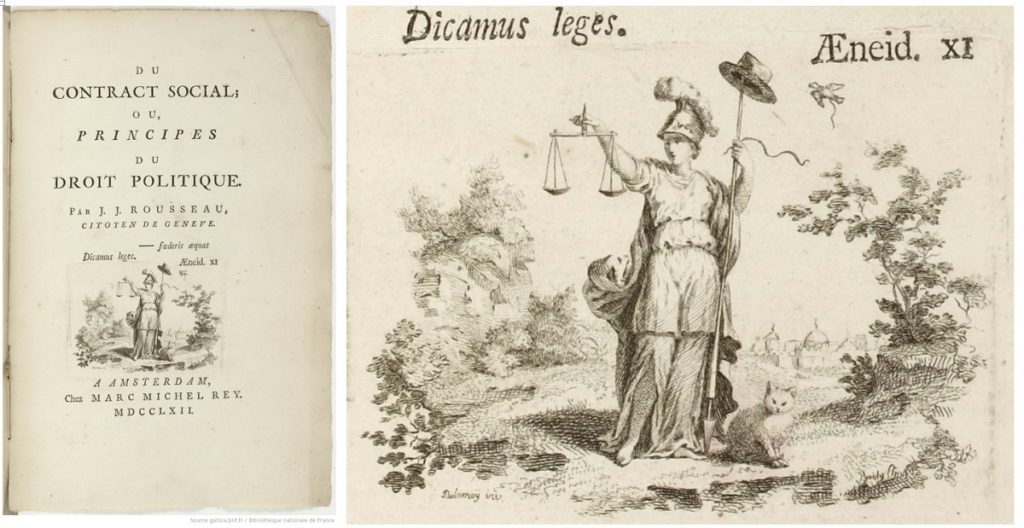
RIGHT: Fig. 12b. Detail of Fig. 12a © Bibliothèque nationale de France.
Oudry’s Le Général embodies the Enlightenment trouble with cats—their challenge to human autonomy and mastery, both subjective and artistic. Considered alongside Perronneau’s seemingly more domestic but similarly resistant cat, Le Général also constitutes a commentary on the virtues of freedom. In this, it both draws on Moncrif’s book while also presaging Jean-Jacques Rousseau’s arguments in favor of liberty, which would have a far wider audience than either Perronneau’s portrait or Oudry’s overdoor painting.[58] Rousseau was a famous cat fancier. In 1763, while living in exile after the publication of Émile, he wrote anxiously to the friend who had taken in his cat Doyenne. He worried that she was not getting enough fresh water and reminded the friend that Doyenne liked to eat at night, so her “pâtée” (sic) should be left out for her.[59] Rousseau’s love for cats was philosophical as well as personal. James Boswell recorded in his journal a conversation with the philosopher in which Rousseau asked if Boswell liked cats. When Boswell replied that he did not, Rousseau replied, “It is my test of character. There you have the despotic instinct of men. They do not like cats because the cat is free and will never consent to be a slave. He will do nothing to your order, as the other animals do.” Boswell objected that a hen also did not follow human orders. Rousseau’s clever reply: “A hen would obey your orders if you could make her understand them. But a cat will understand you perfectly and still not obey them.”[60] Rousseau removed the human enmity for cats from the realm of superstition and installed it firmly in the political realm. The implication, however, was that humans would be better off if they too, like cats, threw off their chains. (Or bells.) It is not surprising, then, to find that the frontispiece to Rousseau’s 1762 Social Contract included a cat sitting self-assuredly at the feet of Liberty (Figs. 12a and 12b).[61]
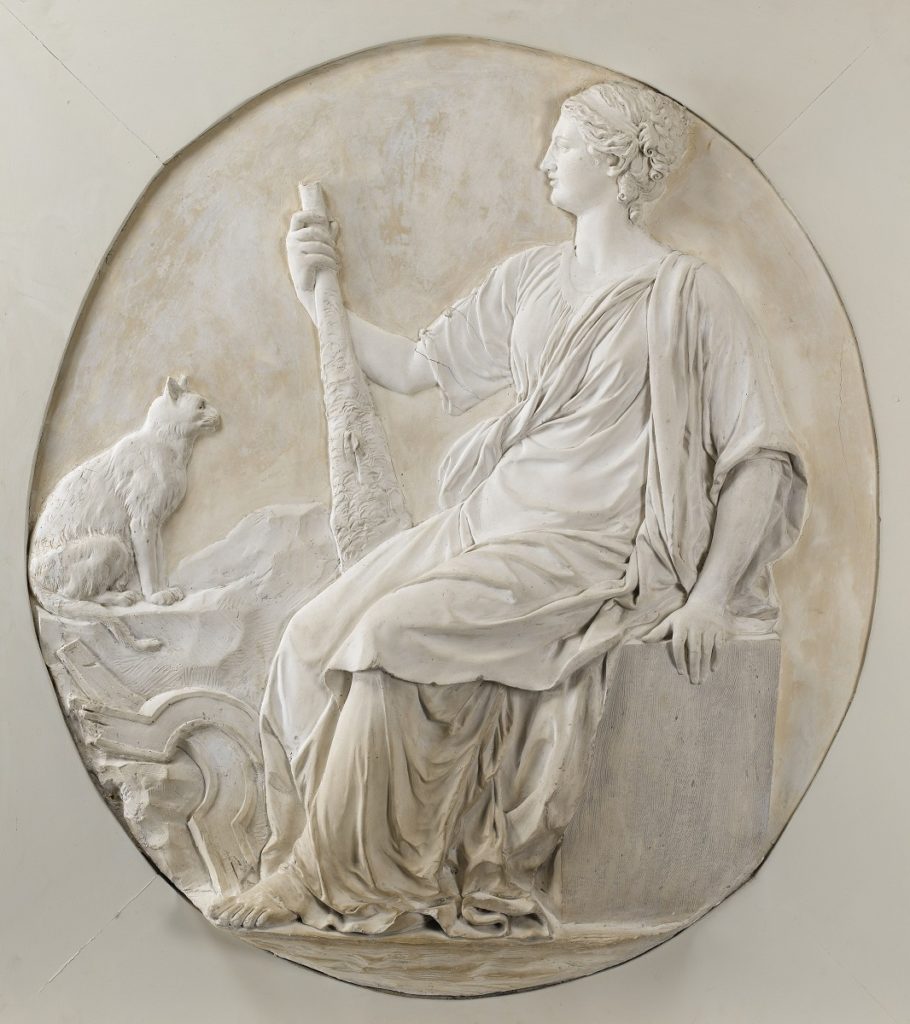
Rousseau was not alone in seeing cats as a model of political freedom. In a letter to Benjamin Franklin, the abbé André Morellet made a joking reference to the outdoor cats that their mutual friend Anne-Catherine Helvétius supported, and proposed shipping them to Franklin in the United States, “their true fatherland,” because as “friends of liberty, they are absolutely out of place under the governments of Europe.”[62] In loving liberty, cats emerge in this comment as somehow not French, a sentiment with which lovers of Chartreux would certainly have disagreed. It may strike us as odd that Louis XV, an absolute monarch, commissioned for his royal palace a portrait of an animal that embodied liberty, but this is only one instance of the ultimately self-destructive elite embrace of the Enlightenment in France. Indeed, by the 1780s, Compiègne would be decorated with an even more explicit feline reference to freedom, in the form of a bas-relief made by Pierre-Nicolas Beauvallet for the king’s bedroom, which depicted Liberty wielding a club and accompanied by a cat at least as truculent as Le Général (Fig. 13).
Rousseau’s association of cats with liberty crystallizes an opinion shared by eighteenth-century writers and artists: cats are resistant to the tyranny of domestication and to representation. And yet humans cannot resist attempting to do both. This is one way in which cats are the soft underbelly of the Enlightenment: soft in the sense that their resistance to human understanding can and does yield, often at surprising moments. It is not a hard rejection of humanity, which one would expect from a truly wild animal incapable of amity across species. Cats retain their wild instincts, but soften them to fit into our world, and there is no question that they have become an integral part of it. The ubiquity of cats in eighteenth-century art, no matter how poorly executed, is evidence of this human-feline interdependence.
The cat is also the soft underbelly of the Enlightenment in another sense. For both its partisans and detractors, the cat embodied one of the Enlightenment’s most appealing but also most radical ideals: personal liberty. It was, after all, one of the problems of Enlightenment political philosophy that the concept of liberty was itself, like the stereotypical cat, capricious (applying as it did only to some human subjects, and even fewer animals), difficult to contain, and potentially destructive, of both the monarchy but also, ultimately, of liberty’s supporters. The cat—alternately considered the embodiment of humanity’s ideal state and of its worst tendencies—represents the Enlightenment’s point of vulnerability, the place where the ideals it advocates are subject to accusations of internal contradiction and moral ambiguity. Perronneau’s and Oudry’s paintings can be said to picture both the guarded embrace of Enlightenment values and the dangers and contradictions associated with bringing those values into human domestic space, be it the bourgeois home, the royal palace, or the artist’s studio.
Today cats are among the most widely kept companion animals in the world, with over 75 million living as pets in the United States alone.[63] Such numbers would have astonished the eighteenth-century artists and writers we have discussed in this essay. If cats were really so independent from us, they could never have reached this prominence. Our chosen images reveal the complexity of the historical moment when their proliferation became possible, as well as the complexity of the animal that so many of us live with now. We could conclude by noting that Oudry, Perronneau, and even Chardin seized upon cats as emblems of the liberties artists could take with the painted surface. Representing cats allowed them to harken to the Enlightenment’s underside—duplicity, rule-breaking, foreignness, female sexuality—but also to imagine those dangers acquiescing partially to the social order. In other words, even as cats challenge Enlightenment philosophical and aesthetic certainties, they also curl up and nap next to us on the sofa, purring contentedly and banishing our fears of their otherness. Cats willingly neutralize the physical and mental powers they so abundantly possess in order to be with us, and in so doing remind us of those liberties we also dampen in order for our societies to cohere.
Amy Freund is a Professor of Art History and the Kleinheinz Family Endowed Chair in Art History at Southern Methodist University in Dallas, TX | Michael Yonan is Associate Professor of Art History at the University of Missouri in Columbia, MO
[1] Barbara Maria Stafford, Body Criticism: Imaging the Unseen in Enlightenment Art and Medicine (Cambridge, MA: MIT Press, 1991), 79.
[2] Pierre Rosenberg, ed., Chardin, trans. Caroline Beamish (London: Royal Academy of Arts, 2000), 114-115, 118.
[3] Our study focuses on representations of actual living felines. A separate inquiry might concern the many cats found in myths and fables popular in Enlightenment France, the starting point for which would be the widely read Aesopian tales of Jean de La Fontaine.
[4] Kathleen Kete, The Beast in the Boudoir: Petkeeping in Nineteenth-Century Paris (Berkeley: University of California Press, 1994), 119; Katharine M. Rogers, Cat (London: Reaktion, 2013), 123, 140; Ingrid Tague, Animal Companions: Pets and Social Change in Eighteenth-Century Britain (University Park, PA: Penn State University Press, 2015), 63-64. On artistic representations specifically see Sarah R. Cohen, “Chardin’s Fur: Painting, Materialism, and the Question of the Animal Soul,” Eighteenth-Century Studies 38:1 (2004), 39-61.
[5] For which see Christopher Frayling, Horace Walpole’s Cat (London: Thames & Hudson, 2009).
[6] Robert Darnton, The Great Cat Massacre and Other Episodes in French Cultural History (New York: Vintage Books, 1984), 74-104.
[7] Rogers, Cat, 172-174; Tracey Hutchings-Goetz, “‘Catching the Cat’; or, Feeling the Feline in Enlightenment Sensualist Philosophy,” paper delivered at the annual conference of the American Society for Eighteenth-Century Studies, Pittsburgh, 2016.
[8] Michel Eyquem de Montaigne, Apology for Raymond Sebond, in The Complete Essays, trans. M.A. Screech (London: Penguin, 1991), 505.
[9] Erica Fudge, Pets (Stockfield: Acumen, 2008), 79-81.
[10] Leonora Cohen Rosenfield, From Beast-Machine to Man-Machine: Animal Soul in French Letters from Descartes to La Mettrie (New York: Oxford University Press, 1941).
[11] Amy Freund, “Sexy Beasts: The Politics of Hunting Portraiture in Eighteenth-Century France,” Art History 42:1 (February 2019), 57-58.
[12] Derrida’s consideration of the cat, part of a longer argument about animals, has been translated by David Wills and published as “The Animal that Therefore I Am (More to Follow),” Critical Inquiry, 28:2 (Winter 2002), 369-418.
[13] David Brooks, “The Loaded Cat,” 21-35, in Sarah Bezan and James Tink, eds., Seeing Animals after Derrida (Lanham MD: Lexington Books, 2018).
[14] Fudge, Pets, 85.
[15] Fudge, Pets, 9.
[16] Georges-Louis Leclerc, Comte de Buffon, Histoire Naturelle, Générale et Particulière (Paris, 1756), vol. VI, 3-54; also excerpted in Rogers, Cat, 86-87. Buffon’s volumes on quadrupeds appeared between 1753 and 1767.
[17] “Le chat est un domestique infidèle, qu’on ne garde que par nécessité, pour l’opposer à un autre ennemi domestique encore plus incommode, et qu’on ne peut chasser.” This and the following English translations come from Buffon’s Natural History, trans. James Smith Barr (London: J. S. Barr, 1797) vol. 6, 1-18.
[18] Buffon, Histoire naturelle, vol. VI, 4. “Comme eux ils savent couvrir leur marche, dissimuler leur dessein, épier les occasions, attendre, choisir, saisir l’instant de faire leur coup, se dérober ensuite au châtiment, fuir et demeurer éloignés jusqu’à ce qu’on les rapelle. Ils prennent aisément des habitudes de société, mais jamais des moeurs; ils n’ont que l’apparence de l’attachement; on le voit à leurs mouvemens obliques, à leurs yeux équivoques; ils ne regardent jamais en face la personne aimée; soit défiance ou fausseté, ils prennents des détours pour en approcher, pour chercher des caresses auxquelles ils ne sont sensibles que pour le plaisir qu’elles leur font.”
[19] Buffon, Histoire naturelle, vol. VI, 4-5. “La forme du corps et le tempérament sont d’accord avec le naturel, le chat est joli, léger, adoit, propre et voluptueux; il aimes ses aises, il cherche les meubles les plus mollets pour s’y reposer et s’ébatre; il est aussi très-porté à l’amour, et, ce qui est rare dans les animaux, la femelle paroît être plus ardente que le mâle, elle l’invite, elle le cherche, elle l’apelle, elle annonce par de hauts cris la fureur de ses désirs, ou plutôt l’excès de ses besoins et lorsque le mâle la fuit ou la dédaigne, elle le pursuit, le mord, et le force pour ainsi dire à la satisfaire, quoique les approches soient toujours accompagnées d’une vive douleur.” It is worth noting that the male pronoun is used in the English translation to reflect the fact that the noun “chat” in French is masculine.
[20] Buffon, Histoire naturelle, vol. VI, 4. “Bien différent de cet animal fidèle, dont tous les sentiments se rapportent à la personne de son maître, le chat paroît de sentir que pour soi, n’aimer que sous condition, ne se prêter au commerce que pour en abuser; et par cette convenance de naturel, il est moins incompatible avec l’homme, qu’avec le chien dans lequel tout est sincere.”
[21] Buffon, Histoire naturelle, vol. VI, 7–8. “On ne peut pas dire que les chats, quoiqu’habitans de nos maisons, soient des animaux entièrement domestiques; ce qui sont le mieux apprivoisés n’en sont pas plus asservis; on peut même dire qu’ils sont entièrement libres, ils ne sont que ce qu’ils veulent, et rien au monde ne seroit capable de les retenir un instant de plus dans un lieu dont ils voudroient s’éloigner.”
[22] Emmanuelle Rassart-Eeckhout identifies the turn of the eighteenth century as a particular moment of this transition in “Le chat, animal de compagnie à la fin de Moyen Âge? L’éclairage de la langue imagée,” in L’animal de compagnie: ses rôles et leurs motivations au regard de l’histoire, ed. Liliane Bodson (Liège: Université de Liège, 1997), 95-118. See also Roger, Cat, 44, 81; and Joan Pieragnoli, La cour de France et ses animaux, XVIe–XVIIe siècles (Paris: Presses Universitaires de France, 2016), 36-38. All three authors note that the cat continued to be an object of suspicion despite its growing acceptance in elite households; Rassart-Eeckhout cites the entry for “Chat” in Antoine Furetière’s 1690 Dictionnaire Universel, which has little good to say of cats; the 1727 edition, essentially unchanged from the first edition, stresses the dangers cats pose to humans and their entirely negative appearance in proverbs.
[23] It was common for Perronneau to depict his sitters holding something associated with their hobbies, interests, or loves. See Dominique d’Arnoult, Jean-Baptiste Perronneau. Portraitiste de génie dans l’Europe des Lumières (Paris: Lienart, 2017), 101, 110, 140, 143, 149, 162. He likewise made multiple portraits of women and young girls holding cats, but among these, the Pinceloup portrait is unusually detailed. A particularly close approximation to Pinceloup, but involving a dog, is Perronneau’s portrait of Félix Louis Lenormant de Mailly en chasseur, also made in 1747 (Orléans: Musée des Beaux-Arts, 2006.1.1).
[24] Rogers calls both “haughty aristocrats;” Rogers, Cat, 84. Elsewhere Rogers references the 1698 fairy tale “La Chatte Blanche,” written by Marie Catherine Jumel de Barneville, baronne d’Aulnoy, as evidence of a cultural imagining of a cat turning into human woman and vice-versa, and therefore the subjective potentiality of felines. Katharine M. Rogers, The Cat and the Human Imagination: Feline Images from Bast to Garfield (Ann Arbor: University of Michigan Press, 1998), 83.
[25] Jean Simonnet, The Chartreux Cat, trans. Jerome M. Auerbach. (Paris: Auerbach, 1990) [Original: Le chat des Chartreux (Paris: Simonnet, 1980)], 6-8; Rogers, Cat, 80-81. On Bellay, see also Rassart-Eeckhout, “Le chat, animal de compagnie,” 111. For the original text of Bellay’s poem, reprinted in the early eighteenth century, see Joachim de Bellay, Vers françois et latins sur la mort d’un petit chat (NP, 1713).
[26] Not all cats were thought of as mousers or pets in the eighteenth century; they were also captured for their fur and, alas, as food.
[27] Simonnet, The Chartreux Cat, 14-15.
[28] Simonnet, The Chartreux Cat, 102. Newer research suggests multiple origins for longhaired cats in the Lake Van region, in Iraqi Kurdistan, and in Uzbekistan, and that these regions exported cats to each other, to Europe, and to India. Complicating matters is that “Persian” and “Angora” are terms often conflated since the eighteenth century. See Jean-Pierre Digard, “Chat des Chats, Chat de Chah? Sur les traces du chat persan,” in Hommes et Terres d’Islam: Mélanges offerts à Xavier de Planhol, ed. Daniel Balland (Tehran: Institut Français de Recherche en Iran, 2000), vol. I, 321-338; and Willem Floor, “A Note on Persian Cats,” Iranian Studies 36:1 (March 2003), 27-42.
[29] Simonnet, The Chartreux Cat, 108. Buffon illustrates four kinds of cats in a categorization that combines geographical origins with contemporary locales to form a rough approximation of modern breeds. Alongside the Chartreux and the Angora, he identifies a chat d’Espagne or tortoiseshell and a common chat domestique who lives near human kitchens. Chardin’s cat, following Buffon, would be an example of the latter.
[30] Buffon’s Natural History, vol. VI, 9-10.
[31] Della Valle, quoted in Simonnet, The Chartreux Cat, 71-72. Buffon cites della Valle’s observation of gray-pelted cats to enhance his discussion of Angoras and Persians. The “marvelous effect” quoted in this passage was often translated as chiaroscuro, for example in Buffon’s Natural History, vol. VI, 9.
[32] Jacques Berchtold, “Les Chats de Jean-Jacques Rousseau,” in Jacques Réda, Jacques Berchtold, and Jean Carlo Flückiger, eds., Chiens et chats littéraires chez Cingria, Rousseau et Cendrars (Geneva: La Dogana, 2002) 46. Berchtold notes that Moncrif was derisively refered to as “Mongriffe” (after cats’ tendancy to scratch) by his peers. See also Rogers, Cat and Human, 87; and Simone Gougeaud-Arnaudeau, Les chats de noble compagnie: anthologie littéraire du XVIIIe siècle (Grandvilliers: La tour verte, 2012), 163-169.
[33] François-Augustin Paradis de Moncrif, Les Chats (Paris: 1727), 20 (ninth letter footnote).
[34] Moncrif, Les Chats, 143.
[35] Moncrif, Les Chats, 145.
[36] Moncrif, Les Chats, 149-150. On not having a physiognomy in the eighteenth century, see Melissa Percival, The Appearance of Character: Physiognomy and Facial Expression in Eighteenth-Century France (Leeds: W.S. Maney & Son, 1999), 8.
[37] “forcé de flatter un visage minaudier souvent difforme ou suranné, presque toûjours sans phisionomie; à multiplier des êtres obscurs sans caractère, sans nom, sans place & sans mérite.” Cited in Michael Müller, “‘Sans nom, sans place & sans mérite?’ Réflexions sur l’utilisation du portrait en France aux XVIIIe siècle,” in Thomas W. Gaehtgens, Christian Michel, Daniel Rabreau, and Martin Schieder, eds., L’art et les normes sociales au XVIIIe siècle (Paris: Éditions de la Maison des Sciences de l’Homme, 2001), 385-386.
[38] Moncrif’s claims tally with Sarah Cohen’s analysis of Charles Le Brun’s physiognomic drawings of humans and animals in “Searching the Animal Psyche with Charles Le Brun,” Annals of Science 67:3 (2010), 353-382. Cohen argues that Le Brun’s drawings of animals and animal/human hybrids demonstrate his interest in “animal psychology” and posit a sensitive animal soul that erodes conventional human/animal hierarchies.
[39] “De mon Minon veux faire le tableau/Besoin seroit d’un excellent pinceau/Pour crayonner si grande gentillesse/Attraits si fins, si mignarde souplesse.” Moncrif, Les Chats, 96. The Duchess was the original owner of the Bibliothèque nationale’s copy of Les Chats, and a funerary monument to one of the duchess’s cats survives in the garden at Sceaux, inscribed, “Icy gît Mar-la-Main, le roi des animaux.” See the online catalogue of the château de Sceaux at http://www.collections.chateau-sceaux.fr/Record.htm?idlist=1&record=19138786124919569689 (accessed 22 Feb 2019).
[40] “Il paroît par cette avanture, que les Chats n’aiment point à représenter; tout ce qui a l’air de sujettion, repugne apparemment à cette indépendance dans laquelle ils sont nez.” Moncrif, Les Chats, 100-102.
[41] Alexandre de Bothuri, the current owner of Le Général, discusses the porphyry vase and its role in his identification of the painting in La mémoire des objets (Montréal: Del Busso, 2015), 34-35, 39. A pair of porphyry vases formerly in the collection of Louis XIV (OA9223 and OA9224, Musée du Louvre) appears to be identical to the one in the Oudry paintings.
[42] On black in eighteenth-century optics and color theory, see Sarah Lowengard, The Creation of Color in Eighteenth-Century Europe (New York: American Council of Learned Societies, 2014), chapter 6; http://www.gutenberg-e.org/lowengard/C_Chap06.html (accessed 22 Feb 2019); John Gage, Color and Meaning: Art, Science, and Symbol (Berkeley: University of California Press, 1999) 30-34, 134; and Alan E. Shapiro, “Artists’ Colors and Newton’s Colors,” Isis 85:4 (December 1994), 600-630.
[43] “Jamais elle nous offre rien de noir que ce qui est, non seulement privé de la lumière en général, mais qui est assez enfoncé pour être absolutment privé de reflets.” Jean-Baptiste Oudry, “Manière d’étudier la couleur en comparant les objets entre eux,” in Jacqueline Lichtenstein and Christian Michel, eds., Les Conférences au temps de Charles-Antoine Coypel 1747–1752, vol. 5, part 1, (Paris: École Nationale Supérieure des Beaux-Arts, 2012), 333. https://www.perspectivia.net/publikationen/conference/conferences_tome5/conferences_tome5_vol1 (accessed 22 Feb 2019).
[44] On black as the absence of light, and the connection between blackness, whiteness, and Enlightenment, see Anne Lafont, “How Skin Color Became a Racial Marker: Art Historical Perspectives on Race,” Eighteenth-Century Studies 51:1 (Fall 2017), 89-113. Although it falls outside the scope of our argument, Lafont’s claims about blackness and whiteness as both aesthetic and racial categories could be brought into dialogue with the visual representation of cats and Moncrif’s assimilation of them to the foreign Other.
[45] Jacqueline Lichtenstein, The Eloquence of Color: Rhetoric and Painting in the French Classical Age, trans. Emily McVarish (Berkeley: University of California Press, 1993), 178-185.
[46] For the most complete documentation of the Compiègne animal portraits, see Hal N. Opperman, Jean-Baptiste Oudry (New York and London: Garland, 1977); Le Général is mentioned in vol. 1, 532. The painting is also briefly referenced, and reproduced in black and white, in Vincent Droguet, Xavier Salmon, and Danièle Véron-Denise, Animaux d’Oudry: Collection des ducs de Mecklembourg-Schwerin (Paris: Réunion des Musées Nationaux, 2003), 30, 34-35.
[47] “… si vous voulez vous amuser, j’entends que ce ne soit pas aux dépens de mon chat.” Jean-Nicolas Dufort de Cheverny, Mémoires sur les régnes de Louis XV et Louis XVI et sur la Révolution, 2 vols. (Paris: Plon, 1886), vol 1, 124-135; cited in Katharine MacDonogh, Reigning Cats and Dogs:
A History of Pets at Court since the Renaissance (St. Martin’s Press, 1999, 139-140.
[48] Mémoires de Mme Campan, première femme de chambre de Marie-Antoinette (Paris: Mercure de France, 1988), 373-374; cited in MacDonogh, Reigning Cats and Dogs, 169-170.
[49] There are two other known Oudry portraits of cats: Two Cats (1725; Ottawa, National Gallery of Canada) and Cat and Kitten (1737; private collection). Neither includes a name but both isolate the cats against an architectural backdrop. See Opperman, Oudry, vol. 1, 484, 531.
[50] “Son chat d’Angora qui guette un oiseau est on ne peut mieux. Physionomie traîtresse; longs poils bien peints, etc.” Cited in Hélène Mouradian et al., Jean-Jacques Bachelier (1724–1806): Peintre du Roi et de Madame du Pompadour (Paris: Somogy, 1999), 139-141.
[51] Elisabeth Hardouin-Fugier,Le peintre et l’animal en France au XIXe siècle (Paris: Éditions de l’Amateur, 2001), 133.
[52] For the popularity of fables and fairy tales featuring animals, see Cohen, “Searching the Animal Psyche.” Oudry himself illustrated La Fontaine’s fables for a luxury edition published between 1755 and 1759; his drawings for the project were executed between 1729 and 1734, at the same moment that he was working on Le Général and his other cat paintings. Opperman, Oudry, I, 99-100.
[53] Gougeaud-Arnaudeau, Les chats de noble compagnie, 123. See also Élisabeth Foucart-Walter and Pierre Rosenberg, The Painted Cat: The Cat in Western Painting from the Fifteenth to the Twentieth Century, trans. Diane Guernsey (NY: Rizzoli, 1988), 40.
[54] On Madame du Deffand’s cats, and her friendship with Walpole, see Gougeaud-Arnaudeau, Les chats de noble compagnie, 177-280. The cat depicted in the medallion portrait is identified as Mme du Deffand’s in Manuel des curieux et des amateurs de l’art, vol. 7 (Zurich: Orell, Fusli, et Cie, 1804), 221.
[55] Moncrif, Les Chats, 135-138. The Dick Whittington legend dates back at least to the early seventeenth century, as a c. 1618–1619 portrait print of Whittington attests.
[56] “Libres dans le choix de leur séjour, ils habitent au gré de leur ambition ou de leur philosophie, les portiques du Monarque, ou le simple toit du Citoyen.” Moncrif, Les Chats, 142.
[57] “Le Chat maître de sa situation, goûte dans le sein de l’abondance, le plaisir pur de la tranquilité ; son adresse & sa sobrieté lui sont des garands toujours certains d’un avenir agréable.” Moncrif, Les Chats, 147.
[58] Berchtold, “Les Chats de Jean-Jacques Rousseau,” provides an exhaustive account of Rousseau’s association of cats and liberty.
[59] Berchtold, “Les Chats de Jean-Jacques Rousseau,” 68.
[60] December 15, 1764; see John Wain, ed. The Journals of James Boswell, 1762–1795 (New Haven and London: Yale University Press, 1991), 117-118.
[61] David Lay Williams, Rousseau’s Social Contract: An Introduction (Cambridge: Cambridge University Press, 2014), 26-29. The cat was already a part of the iconography of liberty as formulated by Cesare Ripa in 1593 (first illustrated edition 1603); see for instance the description and illustration in a later French version, in which the presence of the cat was justified by the fact that “il n’y a point d’Animal qui aime tant la liberté que celuy-là… à cause de quoy quelques Peuples, & particulièrement le Bourguignons, le portoient anciennement pour Devise en leurs Ensiegnes de Guerre.” Jean Baudoin, Iconologie, ou la Science des emblèmes… tirées la plupart de César Ripa (Amsterdam, 1698), 123-125.
[62] “leur véritable patrie,” “amis de la liberté, ils sont absolument déplacés sous le gouvernements d’Europe.” Cited in Gougeaud-Arnaudeau, Les chats de noble compagnie, 117. The logic of cat as friend of liberty reached its apogee in French Revolutionary images such as Pierre-Paul Prud’hon’s 1798 allegory of the French constitution, which features a large domestic cat at the feet of Liberty: https://gallica.bnf.fr/ark:/12148/btv1b6945049r/f1.item (accessed 22 Feb 2019).
[63] This number derives from the statistics of the American Veterinary Medical Association, complied in 2012: https://www.avma.org/KB/Resources/Statistics/Pages/Market-research-statistics-US-pet-ownership.aspx (accessed 22 Feb 2019). The number has likely increased since.
Cite this article as: Amy Freund and Michael Yonan, “Cats: The Soft Underbelly of the Enlightenment,” Journal18 Issue 7 Animals (Spring 2019), https://www.journal18.org/3778.
Licence: CC BY-NC
Journal18 is published under a Creative Commons CC BY-NC International 4.0 license. Use of any content published in Journal18 must be for non-commercial purposes and appropriate credit must be given to the author of the content. Details for appropriate citation appear above.

Pingback: ART 261 Module 2 Assignment: Understanding Scholarship Sources: … – Native Heros
Pingback: ART 261 Module 2 Assignment: Understanding Scholarship Sources: ... - Timely Essay Help
Pingback: Task: 1.) Below are two artworks by the artists Jean-Baptiste... - Timely Essay Help
Pingback: ART 261 Module 2 Assignment: Understanding Scholarship Sources: … – Hook Essays
Pingback: ART 261 Module 2 Assignment: Understanding Scholarship Sources: … | Collepals Essay Writers
Pingback: ART 261 Module 2 Assignment: Understanding Scholarship Sources: … – Dash Do My Homework
Pingback: ART 261 Module 2 Assignment: Understanding Scholarship Sources: ... - My Perfect Essay
Pingback: Task: 1.) Below are two artworks by the artists Jean-Baptiste… – Dash Do My Homework
Pingback: ART 261 Module 2 Assignment: Understanding Scholarship Sources: ... - School Work Expert
Pingback: Task: 1.) Below are two artworks by the artists Jean-Baptiste... - Write My Paper
Pingback: Task: 1.) Below are two artworks by the artists Jean-Baptiste… - Grade Scoping
Pingback: Task: 1.) Below are two artworks by the artists Jean-Baptiste... - My Perfect Essay
Pingback: Task: 1.) Below are two artworks by the artists Jean-Baptiste... - University Term Papers
Pingback: Task: 1.) Below are two artworks by the artists Jean-Baptiste… - Tanswer
Pingback: Task: 1.) Below are two artworks by the artists Jean-Baptiste… - Bessays
Pingback: ART 261 Module 2 Assignment: Understanding Scholarship Sources: … - Bessays
Pingback: ART 261 Module 2 Assignment: Understanding Scholarship Sources: ... - University Term Papers
Pingback: ART 261 Module 2 Assignment: Understanding Scholarship Sources: ... - My Essay Guru
Pingback: ART 261 Module 2 Assignment: Understanding Scholarship Sources: … - Grade Scoping
Pingback: ART 261 Module 2 Assignment: Understanding Scholarship Sources: ... - Write My Paper
Pingback: ART 261 Module 2 Assignment: Understanding Scholarship Sources: … | My Blog
Pingback: ART 261 Module 2 Assignment: Understanding Scholarship Sources: ... - Writer My Assignment
Pingback: ART 261 Module 2 Assignment: Understanding Scholarship Sources: … - Tanswer
Pingback: A lefestett macskák bizarr és mégis lenyűgöző világa - Az Én Macskám
Pingback: Unveiling the Mystery: The “M” on Bengal Cats’ Foreheads – Munchkin Kitten Store
Pingback: Weaving Feline Magic: Cats in Textile Art - purrlosophy.com
Pingback: Felines in Political and Satirical Art: A Symbolic Perspective - purrlosophy.com